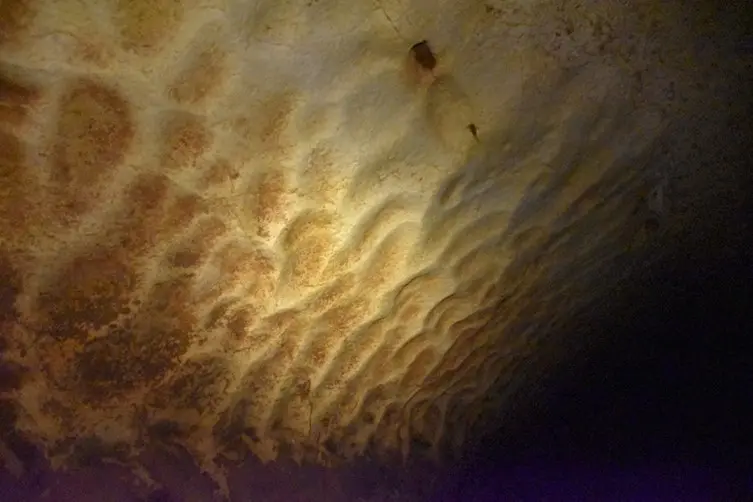Forming singularities in solution erosion
As water flows over soluble rock, it can create remarkable patterns in nature, often with sharp points. Gouge marks, concave depressions surrounded by ridges, are a common example. By combining field measurements, numerical modelling and experiments, we show that the appearance of these shapes results from a geometric mechanism.

In glaciology, karstology, speleology and planetology, regular, periodic patterns of alternating bumps and hollows are often observed on a solid substrate that is dissolving, melting or sublimating. In particular, on the walls of underground caves, concave depressions delimited by sharp ridges can be observed, known in speleology as cupules or gouge marks. These shapes result from the dissolution of limestone by a current of water when the cave shaft was flooded during its formation. According to existing studies, the characteristic size of these patterns is inversely proportional to the speed of the current. Nevertheless, the characteristic shape of a trough surrounded by ridges had not been explained until now.
In this article, we show that the presence of peaks and ridges can be explained geometrically. While it is hydrodynamic mechanisms that lead to the appearance of undulations and fix their characteristic size, it is a geometric mechanism that then transforms smooth bumps into sharp ridges while widening the troughs. To demonstrate this, we propose a combined approach combining observation, modelling and experimentation on a soluble material.
Based on a quantitative analysis of a wall in the Grotte Saint Marcel in Ardèche, we first demonstrate that gouge marks can be interpreted geometrically as including singularities, i.e. places where the local slope varies abruptly. Then, surface evolution models of increasing complexity enable us to explain the formation of these singularities, and to reproduce the emergence of ridges delimiting the units of a cellular structure whose characteristic size increases over time. Finally, we carry out a dissolution experiment controlled by solutal convection, enabling us to observe the emergence of a cellular pattern on a soluble material immersed in water. This pattern is consistent with model predictions and closely resembles the gouge marks observed in the cave. For the experiment, we use a block of salt instead of cave limestone, as its high solubility means that the time taken for the dissolution patterns to appear is much reduced. The mechanism highlighted in this article applies more generally to any ablation process. This applies in particular to interfaces undergoing melting, such as the submerged walls of icebergs or sublimating snowfields, on which gouge-like patterns are sometimes observed, but also to planetary environments conducive to ice sublimation, such as Mars or Pluto.
> Reference : Emergence of tip singularities in dissolution patterns, Martin Chaigne, Sabrina Carpy, Marion Massé, Julien Derr, Sylvain Courrech du Pont and Michael Berhanu, PNAS, 2023, 120 (48) (https://doi.org/10.1073/pnas.2309379120)
Published on November 24th, 2023

